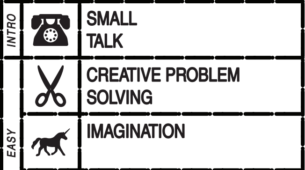For this critical play, I chose to play One Night Ultimate Werewolf, a social deduction game similar to Mafia. One Night Ultimate Werewolf was developed by Ted Alspach and Akihisa Okui and published by Bézier Games. The game is available as a physical card game but also has a mobile app companion that helps guide gameplay (e.g. facilitate narration and secret moves). The game is most enjoyable in groups of 4-10 players—it’s a game that friends, families, and even strangers can enjoy. The bluffing and social dedication mechanisms integrated into the game create high-stakes social interactions between players that makes it exciting and thrilling.
One Night Ultimate Werewolf uses minimal mechanics and a one-round structure which generates rich player dynamics with limited strategic depth. By contrast, the game that we are developing expands on Werewolf’s secret card roles and bluffing mechanics within a multi-round framework to offer a more narratively immersive deduction experience.
In One Night Ultimate Werewolf, each player is assigned a secret role—they are either a villager, werewolf, or other unique roles (e.g. seer, robber, town drunk). Each role has specific actions they can take during the night cycle, such as switching cards, viewing player cards, or viewing a center card. During the day, players discuss and vote on who they believe is the werewolf. The objective of the werewolves is to stay alive, otherwise the villagers win.

Character Playing Cards
When I was playing the game as a villager, I noticed how I easily got swept up in the accusations and storytelling of my counterparts. Since we had such little information to go off of, and many people with special roles didn’t speak out, I was forced to make judgements based on people’s tone, hesitation, and logic. On the other hand, playing a round as the werewolf, I leveraged my newness to the game as a tactic to shamelessly bluff. When I claimed to be the seer and to have checked the center cards (and then another player spoke out because they were the seer), my defense was that I was new to the game, how could I be bold enough to bluff so boldly. And, people bought my defense and I survived! Comparing this bluffing mechanism with our own game, all characters (not just the witch) will have to bluff because each character/role has a secret. This makes the game more dynamic and each player will be more on edge. This makes it more difficult to figure out who is lying because they are the witch and who is lying because they need to keep their secret hidden.
Compared to our game, One Night Werewolf features a very compressed experience—just one round of deduction and a single opportunity to guess correctly. Our game stretches this tension and experience into multiple rounds, which allows players to utilize more strategy throughout the game. Werewolf is very fast paced, which makes it devolve sometimes into a shouting match, while our game will allow players to think more deliberately and act accordingly.
Both Werewolf and our game deliver on the same types of fun: fellowship and challenge. They share similar mechanics of hidden roles, limited time, accusations/voting, and bluffing, to create the dynamics of suspicion and cooperation. Our game builds on the set of mechanics in Werewolf by adding more narratitve character arcs and creating more synergy between characters (e.g. some characters have a motivation to protect another character).
In all, playing Werewolf was incredibly fun and also valuable for our own game design process. By using some of the key mechanics of Werewolf and adding a more narrative spin to it, we are able to add to the thrill and player engagement/experience of our game.



